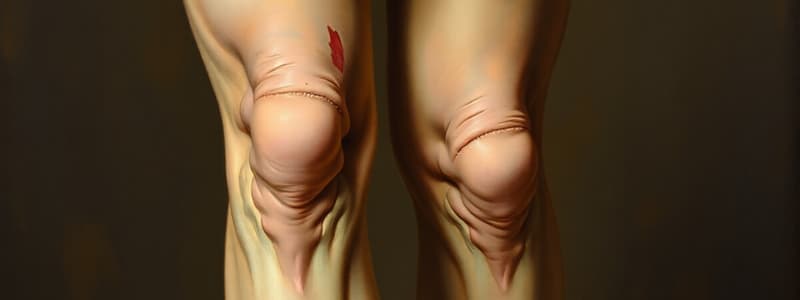Podcast
Questions and Answers
What is the commonest cause of genu varum in children aged 1.5-2 years?
What is the commonest cause of genu varum in children aged 1.5-2 years?
- Dietetic insufficiency
- Rickets (correct)
- Developmental factors
- Ligamentous injury
At what age does genu valgum usually correct itself if it is developmental or physiological?
At what age does genu valgum usually correct itself if it is developmental or physiological?
- 6-8 years (correct)
- 12 years
- 10 years
- 4 years
Which of the following statements is true about coxa vara and coxa valga?
Which of the following statements is true about coxa vara and coxa valga?
- Coxa vara occurs at an angle more than 130°.
- Coxa valga occurs at an angle less than 110°.
- Neither condition requires surgical intervention.
- Both conditions lead to gait disability. (correct)
What surgical procedure is commonly required for advanced cases of genu varum in adults?
What surgical procedure is commonly required for advanced cases of genu varum in adults?
Which type of osteotomy is performed to correct cubitus valgus and cubitus varus?
Which type of osteotomy is performed to correct cubitus valgus and cubitus varus?
What is the normal carrying angle for the elbow?
What is the normal carrying angle for the elbow?
Which disease is associated with defective osteoid formation?
Which disease is associated with defective osteoid formation?
What is the usual angle of the neck-shaft of the femur at adulthood?
What is the usual angle of the neck-shaft of the femur at adulthood?
What is the primary treatment for most common orthopaedic deformities?
What is the primary treatment for most common orthopaedic deformities?
What condition is characterized by an angle less than 110° in the neck-shaft angle of the femur?
What condition is characterized by an angle less than 110° in the neck-shaft angle of the femur?
What is the primary cause of hypercalcemia in primary hyperparathyroidism?
What is the primary cause of hypercalcemia in primary hyperparathyroidism?
What is one of the primary causes of infantile rickets?
What is one of the primary causes of infantile rickets?
Which symptom is NOT associated with osteoporosis?
Which symptom is NOT associated with osteoporosis?
What can be a surgical treatment option for severe deformities due to rickets that do not improve with medication?
What can be a surgical treatment option for severe deformities due to rickets that do not improve with medication?
Which skeletal deformity is commonly associated with rickets?
Which skeletal deformity is commonly associated with rickets?
Which dietary components are essential for the treatment of infantile rickets?
Which dietary components are essential for the treatment of infantile rickets?
What characterizes Osteogenesis Imperfecta?
What characterizes Osteogenesis Imperfecta?
Bone resorption in hyperparathyroidism is primarily caused by which type of cells?
Bone resorption in hyperparathyroidism is primarily caused by which type of cells?
What is a characteristic sign of infantile rickets?
What is a characteristic sign of infantile rickets?
What is a relevant method for diagnosing osteoporosis?
What is a relevant method for diagnosing osteoporosis?
What is the recommended orthopedic management for Osteogenesis Imperfecta?
What is the recommended orthopedic management for Osteogenesis Imperfecta?
What does X-ray imaging reveal in patients with rickets?
What does X-ray imaging reveal in patients with rickets?
What role does calcitonin play in osteoporosis treatment?
What role does calcitonin play in osteoporosis treatment?
What is a common outcome of untreated primary hyperparathyroidism?
What is a common outcome of untreated primary hyperparathyroidism?
Which of the following is NOT a clinical feature of rickets?
Which of the following is NOT a clinical feature of rickets?
Which condition is characterized by decreased bone mass and is typically evaluated through DEXA scans?
Which condition is characterized by decreased bone mass and is typically evaluated through DEXA scans?
The Coeliac type of rickets is primarily due to:
The Coeliac type of rickets is primarily due to:
What treatment is specifically needed for renal rickets?
What treatment is specifically needed for renal rickets?
Which type of Osteogenesis Imperfecta manifests in late childhood?
Which type of Osteogenesis Imperfecta manifests in late childhood?
What is one of the surgical considerations in managing Osteogenesis Imperfecta?
What is one of the surgical considerations in managing Osteogenesis Imperfecta?
Flashcards are hidden until you start studying
Study Notes
Orthopaedic Deformities
- Deformities deviate from the normal appearance of a body part.
- Deformities can be congenital or acquired.
- Many deformities require surgical intervention.
Knee Deformities
- Genu Varum (Bow Leg):
- In infants:
- Common cause is developmental and physiologic.
- Deformity corrects by age four.
- No treatment is necessary.
- In children (aged 1.5-2 years):
- Rickets is a common cause.
- It's associated with systemic signs, symptoms, and lab findings.
- Treatment focuses on correcting the cause, usually vitamin D deficiency.
- Osteoclasis or osteotomy is required in certain cases.
- In adults:
- Osteoarthritis, mal-united fracture, ligamentous injury, and Paget's disease are main causes.
- Treatment focuses on surgical correction.
- In infants:
- Genu Valgum (Knock Knees):
- Valgus knee up to age four:
- Usually developmental or physiologic.
- Corrects by 6-8 years.
- If corrective, a supracondylar osteotomy of the femur is required.
- Valgus knee up to age four:
Hip Deformities
- Normal neck-shaft angle of the proximal femur is 160° at birth and decreases to 125° in adulthood.
- Coxa vara: angle less than 110°.
- Coxa valga: angle more than 130°.
- Both lead to gait disability, secondary spinal pain, and deformity.
- Treatment is corrective subtrochanteric osteotomy.
Elbow Deformities
- Normal carrying angle is 10-15 degrees of valgus.
- Cubitus valgus: angle above 10-15 degrees.
- Cubitus varus: angle below 10-15 degrees.
- Both deformities are surgically corrected through a wedge osteotomy at the lower humerus.
Bone Softening Diseases
- Bone is a type of connective tissue formed of cells and matrix.
- Two types of bone cells:
- Osteoblasts: bone forming cells.
- Osteoclasts: bone resorbing cells.
- Bone softening diseases can be caused by:
- 1-Defective formation of osteoid (e.g. osteogenesis imperfecta).
- 2-Defective mineralization of osteoid (e.g. rickets).
- 3-Increased resorption of bone by osteoclasts (e.g. hyperparathyroidism).
- 4-Decreased formation of bone by osteoblasts (e.g. osteoporosis).
Osteogenesis Imperfecta
- General mesenchymal disorder characterized by:
-
- Defective osteoid production, leading to weak bone and multiple fractures.
-
- Defective collagen production, leading to joint hyperlaxity and blue sclera.
-
- Several types of the disease with varying severity:
-
- Congenital Type: still-born or born with multiple fractures.
-
- Infantile type: manifestations in early infancy with multiple fractures.
-
- Tarda type: manifestations in late childhood.
-
- No specific treatment exists.
- Orthopedic management focuses on:
- Preventing fractures and deformities with supportive devices.
- Treating existing fractures.
- Correcting deformities through surgery if necessary.
Rickets
- Disease of growing bone due to inadequate calcification of bone matrix.
- Causes:
- Infantile Rickets: deficient intake of vitamin D and lack of sunlight exposure. Manifests between 6 months and 3 years of age.
- Coeliac Rickets: deficient absorption of fat and vitamin D due to hereditary intolerance to gluten.
- Renal Rickets: disturbed calcium phosphorus metabolism due to renal dysfunction.
- Clinical Picture:
- Important bony manifestations are deformities causing bow legs (genu varum) or knock knees (genu valgum).
- Characteristic Signs:
- Boxy-bossy skull
- Rickety rosary
- Pigeon chest
- Harrison Sulcus
- Broad metaphysis
- Marfan sign
- X-ray: shows bone rarefaction, broadened and cupped metaphyses with brush border.
- Treatment:
- Infantile rickets: good diet rich in calcium, phosphorus, and vitamin D, exposure to sunlight, and administration of vitamin D and calcium.
- Renal rickets: administration of high doses of vitamin D and calcium.
- Severe deformities may require osteotomy if medical treatment is ineffective.
Hyperparathyroidism
- Primary hyperparathyroidism results from increased parathyroid hormone secretion due to hyperplasia or tumor.
- This increases osteoclastic bone resorption leading to:
-
- Hypercalcemia.
-
- Recurrent renal calculi.
-
- Bone resorption causes bone deformities, cysts, and pathological fractures.
-
- Surgical treatment is through excision of parathyroid adenoma.
Osteoporosis
- Diminished bone mass due to decreased bone formation by osteoblasts with aging and menopause.
- Common sites affected:
- Vertebral column: weakening of vertebrae. Causes vertebral collapse, back pain, kyphosis, and radiographic appearance of collapsed or biconcave vertebrae.
- Proximal femur.
- Proximal humerus.
- Distal radius.
- Diagnosis: bone densitometry (DEXA).
- Treatment:
-
- Adequate diet rich in calcium, vitamin D, and proteins.
-
- Daily exercises and exposure to sunlight.
-
- Medications: calcium, vitamin D, calcitonin, bisphosphonates, and hormone replacement therapy (HRT) in select cases.
-
Studying That Suits You
Use AI to generate personalized quizzes and flashcards to suit your learning preferences.





